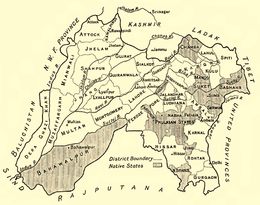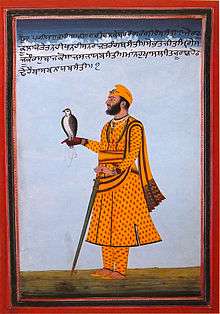Jind State
| Jind & Sangrur State | |||||
| Princely State of British India (1809–1948) | |||||
| |||||
|
Coat of arms | |||||
 | |||||
| Capital | Sangrur | ||||
| History | |||||
| • | Established | 1763 | |||
| • | Independence of India | 1948 | |||
| Area | |||||
| • | 1931 | 3,460 km2 (1,336 sq mi) | |||
| Population | |||||
| • | 1931 | 324,676 | |||
| Density | 93.8 /km2 (243 /sq mi) | ||||
| Today part of | Punjab & Haryana state of India | ||||
| | |||||
Jind State was a Cis-Sutlej state princely state of India during the British Raj until India's independence in 1947.
The state was some 3,260 km2 (1,260 sq mi) in area and its annual income was Rs.3,000,000 in the 1940s.
History
The princely state of Jind & Sangrur was founded in 1763.[1] The rulers belonged to the Phulkian dynasty. It was a Cis-Sutlej state, ruled by the Scindhia dynasty of the Maratha Empire, various small Punjabi kingdoms of the Cis-Sutlej states paid tributes to the Marathas, until the Second Anglo-Maratha War of 1803-1805, after which the Marathas lost this territory to the British.[2] [3] [4] On 25 April 1809 Jind became a British protectorate. Gajpat Singh ruled under the title of raja until 1789, then Bhag Singh until 1819, Fateh Singh until 1822, and Sangat Singh until 1834. After a vacancy of three years, Sarup Singh ruled until 1864, succeeded by Raghubir Singh, who took the title Raja-i Rajgan in 1881. In 1887 he was succeeded by Ranbir Singh, who became Maharaja in 1911 and continued to rule the state until its accession to India in 1947. Ranbir Singh, last Ruler of Jind, was called Colonel His Highness Farzand-i-dilband Rasikh-ul-itikad Daulat-i-englishia Raja-i-rajgan Maharaja Sir Ranbir Singh Rajendra Bahadur.
On 20 August 1948, with the signing of accession to India, Jind became a part of the Patiala and East Punjab States Union and ceased to exist as a separate state. Jind town and district now form a part of Indian state of Haryana.
Postage stamps prior to King George V consisted of Indian stamps over printed as "Jhind State", with the letter 'H' in the name. On the George V stamps, the 'H' is omitted and is overprinted as "Jind State" (Reference actual stamps from the Victorian, Edward VII and George V eras).
Rulers of Jind
The rulers of the state bore the title of 'Raja' until 1881.[5] They had the privilege of a 13-gun salute.[6][7]
Claiming descent from Jaisal, founder of Jaisalmer State in 1156, the founder of this Sikh dynasty, Phul Singh, was Chaudhary (Governor) of a province to the south east of Delhi. Phul’s descendants founded three States: Patiala, Jind and Nabha. Phul had six sons, Tiloka Ram Singh, Rudh, Chunu, Jhandu, and Takhtmal. Tiloka had two sons, Gurudutta and Sukh Chain. Sukh Chain founded Jind, which was ruled by his descendants, while Gurudatta's descendants ruled Nabha State.[8]
 Raja Sangat Singh |
 Maharaja Raghbir Singh, photographed in 1875, ruled Jind until his death in 1887 |
 Maharaja Sir Ranbir Singh |
Rajas
- (? 1652) Choudhary Phula Singh
- (? 1687) Tiloka Singh
- ?1676 - 1751 Sukhachain
- ? 1764 Alam Singh
- ?17.. - 17.. Bulki Singh
- 1763 - 11 Nov 1789 Gajpat Singh (b. 1738 - d. 1789) (imprisoned in Delhi 1767 - 1770)
- 11 Nov 1789 – 16 Jun 1819 Bhag Singh (b. 1760 - d. 1819)
- Mar 1813 - 23 Jun 1814 Rani Sobrahi Kaur (f) -Regent (d. 1814)
- 23 Jun 1814 – 16 Jun 1819 Fateh Singh -Regent (b. 1789 - d. 1822)
- 16 Jun 1819 - 3 Feb 1822 Fateh Singh (s.a.)
- 3 Feb 1822 - 4 Nov 1834 Sangat Singh (b. 1810 - d. 1834)
- 30 Jul 1822 - 1827 Rani Mai Sahib Kaur (f)-Regent (d. af.1847) (1st time)
- 4 Nov 1834 - 8 Mar 1837 Rani Mai Sahib Kaur (f)-Regent (s.a.) (2nd time)
- 8 Mar 1837 – 26 Jan 1864 Sarup Singh (b. 1812 - d. 1864)
- 26 Jan 1864 – 24 May 1881 Raghubir Singh (b. 1834 - d. 1887) (from 31 Dec 1875, Sir Raghubir Singh)
Raja i Rajgan
- 24 May 1881 - 7 Mar 1887 Sir Raghubir Singh (s.a.)
- 7 Mar 1887 – 12 Dec 1911 Ranbir Singh (b. 1879 - d. 1948) (from 1 Jan 1909, Sir Ranbir Singh)
- 7 Mar 1887 – 10 Nov 1899 .... -Regent
Maharaja
12 Dec 1911 – 15 Aug 1947 Sir Ranbir Singh (s.a.)
See also
References
- ↑ According to the World Statesmen website
- ↑ A Comprehensive History of Medieval India: From Twelfth to the Mid ... - Farooqui Salma Ahmed, Salma Ahmed Farooqui - Google Books. Books.google.co.in. Retrieved 2012-05-26.
- ↑ History Of The Marathas - R.S. Chaurasia - Google Books. Books.google.co.in. Retrieved 2012-05-26.
- ↑ https://books.google.com/books?id=Nyk6oA2nOlgC&pg=PA379&lpg=PA379&dq=%22second+anglo+maratha+war%22+sutlej&source=bl&ots=XGHcTeQC7h&sig=tGnkkkS6o63cT5mX-pIv7R9PtsQ&hl=en&sa=X&ei=DmvDT-HOKcHWrQfj2LjhCQ&ved=0CFYQ6AEwBw#v=onepage&q=%22second%20anglo%20maratha%20war%22%20sutlej&f=false
- ↑ Princely States of India
- ↑ G. B. Malleson, An historical sketch of the native states of India. London 1875. Reprint Delhi 1984
- ↑ Jind - Princely State (13 gun salute)
- ↑ Bhagat Singh, A History of Sikh Misals
External links
 Media related to Jind State at Wikimedia Commons
Media related to Jind State at Wikimedia Commons
Coordinates: 31°07′N 77°38′E / 31.117°N 77.633°E
